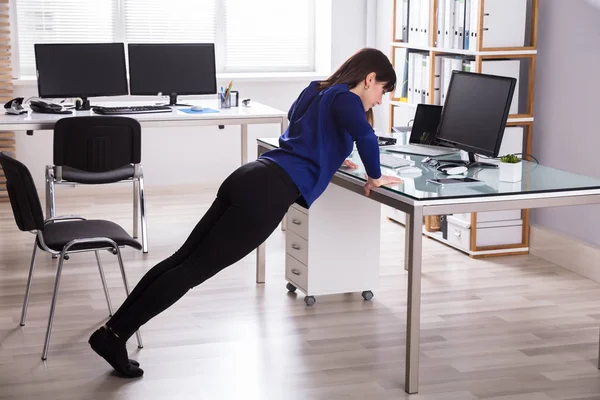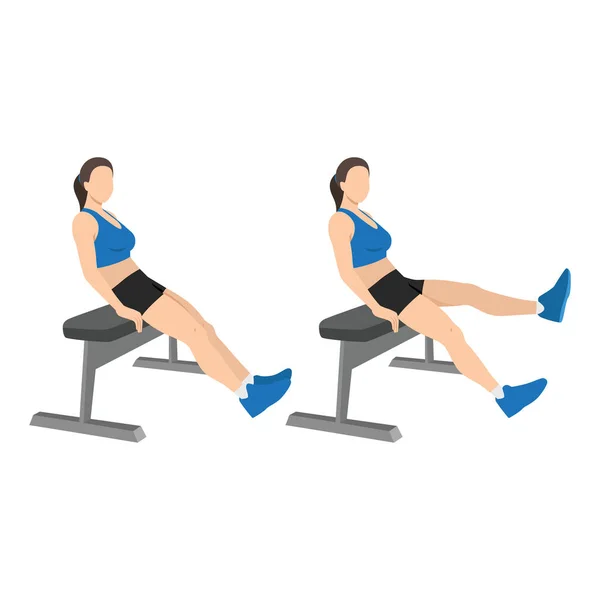Office workers, stop ignoring these exercises! Sitting at a desk can lead to a number of health problems, including poor posture, back pain, obesity, and chronic diseases. Exercise is essential for maintaining your health and well-being, and it can be done even if you’re sitting at a desk all day. Learn about the benefits of exercise for office workers and get some simple exercises that you can do at your desk or in a nearby space. Here is what researchers found;
A number of studies have shown that exercise can lead to increased productivity in office workers. For example, a study by the University of Warwick found that office workers who took a brisk walk for 30 minutes three times a week had a 15% higher weekly productivity rate than those who did not exercise.
Another study, by the University of Exeter, found that office workers who exercised regularly had a 25% lower risk of developing mental health problems such as depression and anxiety. These problems can have a significant impact on productivity, so reducing the risk of developing them can lead to increased productivity.
Benefits of exercise for office workers
Exercise has many benefits for office workers, including:
- Improved physical health: Exercise can help to reduce the risk of developing chronic diseases such as heart disease, stroke, type 2 diabetes, and some types of cancer. It can also help to improve cardiovascular health, reduce blood pressure, and strengthen bones and muscles.
- Improved mental health: Exercise can help to reduce stress and anxiety, improve mood, and boost cognitive function. It can also help to improve sleep quality and reduce the risk of developing depression.
- Increased productivity: Exercise can help to increase energy levels and reduce fatigue. This can lead to improved productivity at work.
- Reduced absenteeism: Exercise can help to improve overall health and reduce the risk of illness and injury. This can lead to reduced absenteeism from work.
- Improved morale: Exercise can help to improve mood and create a more positive work environment.
If you’re an office worker, there are a number of things you can do to increase your productivity through exercise. Here are a few tips:
- Aim for at least 30 minutes of moderate-intensity exercise most days of the week.
- Find an activity that you enjoy and that fits into your schedule.
- Start slowly and gradually increase the intensity and duration of your workouts over time.
- If you’re short on time, break up your exercise into shorter sessions.
- Exercise with a friend or colleague to help you stay motivated.
Even a small amount of exercise can make a big difference in your productivity. So make time for exercise today and see the benefits at work!
RELATED: 6 Best Exercises for Better Joint Health After 30
Best Exercises for Office Workers
Here are some exercises that office workers can do:
Desk push-ups

Desk push-ups are a great way to strengthen your chest, triceps, and shoulders without having to leave your desk. They are also a good exercise for beginners, as they can be modified to make them easier or more difficult.
To do a desk push-up:
- Place your hands shoulder-width apart on the edge of your desk.
- Step back so that your body forms a straight line from your head to your heels.
- Lower your body until your chest touches the desk, then push back up to the starting position.
- Repeat 10-15 times.
If you find desk push-ups to be too difficult, you can modify them by doing them on your knees or by placing your feet on a chair. You can also make them more difficult by doing them with your feet elevated on a box or platform.
Tips:
- Keep your back straight and your core engaged throughout the exercise.
- Do not let your hips sag or your back arch.
- Lower your body until your chest touches the desk, then push back up to the starting position.
- Breathe deeply and evenly throughout the exercise.
Seated knee-to-chest

The seated knee-to-chest stretch is a simple and effective way to stretch the hamstrings, lower back, and hip flexors. It is also a good stretch to do if you have tight hamstrings from sitting for long periods of time.
To do the seated knee-to-chest stretch:
- Sit on the floor with your legs extended in front of you.
- Bend one knee and bring your foot up to your inner thigh.
- Loop your hands behind your knee and gently pull it towards your chest.
- Keep your back straight and your core engaged.
- Hold the stretch for 30-60 seconds.
- Repeat with the other leg.
Tips:
- If you cannot reach your foot to your inner thigh, you can use a strap or towel to assist you.
- Do not force the stretch. If you feel any pain, stop immediately.
- Breathe deeply and evenly throughout the stretch.
Modifications:
- If you have tight hamstrings, you can modify the stretch by bending your standing leg slightly.
- If you have lower back pain, you can modify the stretch by placing a pillow or cushion under your lower back.
Squats

Squats are a compound exercise that works multiple muscle groups in the lower body, including the quadriceps, hamstrings, glutes, and calves. They are also a great exercise for strengthening the core muscles.
To do a squat:
- Stand with your feet shoulder-width apart and your toes slightly pointed out.
- Bend your knees and lower your body until your thighs are parallel to the ground.
- Make sure to keep your back straight and your core engaged.
- Push back up to the starting position.
- Repeat 10-15 times.
If you find squats to be too difficult, you can modify them by doing them against a wall or by using a chair for support. You can also make them more difficult by adding weight, such as dumbbells or a barbell.
Tips:
- Keep your back straight and your core engaged throughout the exercise.
- Do not let your knees go past your toes.
- Push back up to the starting position using your heels.
- Breathe deeply and evenly throughout the exercise.
Modifications:
- For an easier version, do squats against a wall or use a chair for support.
- For a more difficult version, add weight, such as dumbbells or a barbell.
RELATED: 13 Most Effective Exercises To Slow Muscle Aging
Desk plank

The desk plank is a great isometric exercise that works your core muscles, including your rectus abdominis (abs), transverse abdominis (deep core muscles), and obliques. It is also a good exercise for strengthening your shoulders and back.
To do a desk plank:
- Place your forearms on the edge of your desk, shoulder-width apart.
- Make sure your body forms a straight line from your head to your heels.
- Hold the position for 30-60 seconds.
If you find the desk plank to be too difficult, you can modify it by doing it on your knees. You can also make it more difficult by raising one leg or both legs at a time.
Tips:
- Keep your back straight and your core engaged throughout the exercise.
- Do not let your hips sag or your back arch.
- Keep your shoulders relaxed and your head in line with your spine.
- Breathe deeply and evenly throughout the exercise.
Modifications:
- For an easier version, do the desk plank on your knees.
- For a more difficult version, raise one leg or both legs at a time. You can also try holding the position for a longer period of time.
Seated flutter kicks

Seated flutter kicks are a simple exercise that can help to strengthen your core muscles and improve your flexibility. They are especially beneficial for office workers, who often spend hours sitting at a desk.
To do seated flutter kicks, follow these steps:
- Sit in a chair with your feet extended in front of you.
- Raise one leg a few inches off the ground and flutter it up and down for 30 seconds.
- Repeat with the other leg.
- Do 2 sets of 30 seconds on each leg.
Safety guidelines:
- Make sure to warm up before doing any exercise, including seated flutter kicks.
- Do not force the movement or raise your leg too high.
- If you feel any pain, stop the exercise immediately.
- Be sure to hydrate before, during, and after your workout.
- If you have any health concerns, be sure to talk to your doctor before starting any new exercise program.
Neck rolls

Neck rolls are a simple exercise that can help to improve neck range of motion, reduce muscle tension, and relieve pain. They are especially beneficial for office workers, who often spend hours hunched over a desk.
To do neck rolls, follow these steps:
- Sit or stand in a comfortable position with your shoulders relaxed and your back straight.
- Slowly tilt your head to the right, bringing your ear towards your shoulder.
- Hold for a few seconds, then slowly roll your head forward until your chin is tucked to your chest.
- Hold for a few seconds, then slowly roll your head to the left, bringing your ear towards your shoulder.
- Continue rolling your head in a circular motion, repeating steps 2-4.
You can do neck rolls in either direction, but it is important to start slowly and gradually increase the range of motion as your neck becomes more flexible. Do not force the movement, and stop if you experience any pain.
Neck rolls can be done at any time of day, but they are especially beneficial to do first thing in the morning or after a long period of sitting. You can do neck rolls as often as you like, but it is important to listen to your body and rest when needed.
Don’t miss: 5 Best Exercises To Relieve Your Lower Back Pain
Shoulder rolls

Shoulder rolls are a simple exercise that can help to improve shoulder range of motion, reduce muscle tension, and relieve pain. They are especially beneficial for office workers, who often spend hours hunched over a desk.
To do shoulder rolls, follow these steps:
- Stand or sit with your shoulders relaxed and your arms at your sides.
- Slowly roll your shoulders forward in a circular motion.
- Reverse the direction and slowly roll your shoulders backward in a circular motion.
- Continue rolling your shoulders forward and backward for 10-15 repetitions in each direction.
Shoulder rolls can be done at any time of day, but they are especially beneficial to do first thing in the morning or after a long period of sitting. You can do shoulder rolls as often as you like, but it is important to listen to your body and rest when needed.
Arm stretches

Instructions:
- Stand with your feet shoulder-width apart and your right arm raised above your head.
- Bend your right elbow and bring your hand behind your head, touching your shoulder blade with your fingertips.
- Use your left hand to gently push your right elbow backwards until you feel a stretch in the back of your right triceps muscle.
- Hold the stretch for 20-30 seconds.
- Repeat on the other side.









